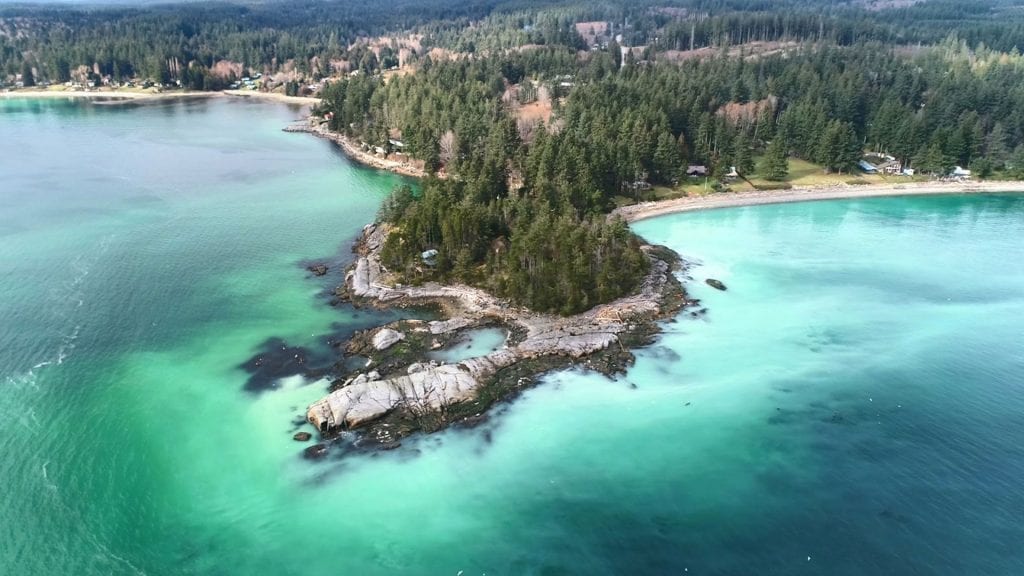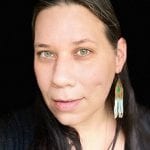Tla’amin Nation in B.C. is welcoming and guarding the return of herring spawn
kʷu ƛaʔayin t̓ɛt̓ɛkʷu ɬagət — or “The herring are beginning to spawn,” in ʔayʔaǰuθəm (Ay-a-ju-thum), the language of Tla’amin First Nation. Once a time of rejoicing, now it signifies a time of guarding against roe fishery.

Herring spawn is a welcome sight in the waters of Lang Bay, Tla’amin territory, 2021. Photo by Alex Sutcliffe.
It’s been a welcome sight for millennia for the Tla’amin Nation — every year in March or April, the waters would turn milky white as the herring sperm fertilized eggs and attached to algae beds of kelp and eelgrass, says Chileneh Scott Galligos, a fisheries technician with Tla’amin.
Tla’amin territory includes the lands and waters surrounding the northern Gulf of Georgia — east of Vancouver Island, along British Columbia’s Sunshine Coast.
Galligos remembers the community gathering on the beach to set out yellow cedar branches for the herring to lay their eggs on.
“We called them the herring winds,” he says. “I remember seeing it rolling up in the high surf … Running as a child in high winds and storms, the waves crashing in this herring roe, just rolling up on the beach, thick.
“As a child it would be knee-high.”
Herring was once an abundant foundation species for their community.
For millennia, herring accounted for “up to 90 per cent of Tla’amin’s traditional diet,” says Tiy’ap thote Erik Blaney, executive council member for Tla’amin First Nation.
Dana Lepovsky, an archaeologist who teaches at Simon Fraser University, worked towards these findings with Tla’amin Nation and other researchers.
But herring numbers have steadily declined over the past few decades, impacting bigger, keystone species that depend on it.
There have been no salmon for the community in five years, says Galligos.
In the 1980s the region’s herring was overfished by the commercial industry, and as a result, the silvery fish require vigilant stewardship by Tla’amin and other local nations, says Blaney.
On March 9, Fisheries and Oceans Canada [DFO] opened the commercial herring roe fishery in the Strait of Georgia, just south of Tla’amin’s territory.
Now representatives from Tla’amin say they’re worried DFO will try and open their waters to commercial herring roe fishers — and Blaney says Tla’amin Nation is prepared to protect their territory.
Tla’amin on guard against overfishing
DFO was operating herring test fishing vessels in Tla’amin territory in early March, conducting herring spawn biomass and DNA surveys, according to representatives from Tla’amin.
Blaney says he’s concerned because in 1986 the commercial fishery “wiped out the once populous herring stocks in Tla’amin territory, leaving the Tla’amin community without access to its essential sustenance resource, which is still struggling to return.”
Galligos is worried assessment vessels in their area could indicate a potential opening in their waters.
“This resulted in no spawn for over 30 years,” says Galligos. “Now it’s slowly coming back.”
Tla’amin Nation is monitoring any vessels coming into the Tla’amin Fishing Area and will turn any vessels around, says Blaney.
The Tla’amin Fishing Area is defined within the Tla’amin Final Agreement — the treaty that was signed in 2014 between Tla’amin First Nation and the provincial and federal governments.
“Tla’amin Nation continues to warn DFO that any commercial opening within the Tla’amin Fishing Area will be an attack on Tla’amin’s constitutionally protected treaty rights,” says Blaney.
“We are a self-governing Nation with treaty rights that we will assert over what few herring we have left in our waters,” says Hegus John Hackett, who was elected to Tla’amin’s government in November 2020.
New science supports oral history
In neighbouring Strait of Georgia, just south of Tla’amin territory, DFO has opened herring fisheries, despite a 60 per cent decline in stocks.
Local First Nations and conservancy groups are concerned that DFO has again recommended a 20 per cent harvest rate for herring in the Strait of Georgia.
“We urge DFO to place a moratorium on or seriously reduce the commercial herring fisheries in the SOG,” write representatives from the volunteer organization Conservancy Hornby Island.
In 2018, a DFO report on the status of Pacific Herring, found that a “reduction in harvest rate from 20 per cent to 10 per cent was the most effective means of mitigating stock assessment errors.”
DFO biomass assessments for Strait of Georgia showed the herring spawn stock has declined from 129,000 metric tonnes in 2016, to 85,700 tonnes in 2019, and is predicted to fall to 54,242 tonnes in 2020 – a 60 per cent decline in four years.
“Of the five herring fisheries that the DFO has managed on the B.C. coast, four have collapsed, leaving the Strait of Georgia as the only remaining viable herring spawn on the coast,” says Conservancy Hornby Island.
When herring are in trouble, so are salmon, says Galligos.
Since time immemorial, salmon have been hatching in Tla’amin rivers, following the coastline, feeding on young herring. Herring spawn is a foundation food source for these young salmon, says Galligos, and protecting salmon requires protecting herring spawn.
Eighty per cent of Chinook salmon diet is herring, over 80 per cent of endangered southern resident orcas diet is Chinook, research has found.
“It’s just a house of cards, you can’t pull from the bottom without it collapsing,” says Galligos.
DFO was not available for comment in time for publication.
New research suggests herring may be at risk for another reason — like salmon, they apparently return home to spawn. Through fieldwork at Hakai Institute, researchers investigated genetic data collected from spawning herring and found “that herring [return] home to their natal sites to spawn.”
This may increase the vulnerability of herring populations to overexploitation of fisheries, the study concludes.
miʔəmštəm kʷisəm ‘We will put branches out tomorrow‘
Blaney was four during the herring spawn of 1986, and he says he remembers it well.
He describes the gathering of herring roe on branches at the village site of ƛɛkʷanəm, known as Scuttle Bay.
“There were inches of eggs on our branches. And now when we set our branches and over the last two, three years, it just looks like little snowflakes,” he says.
“It’s almost not even worth setting.”
Access to the precious resource has been so limited that it threatens the culture and way of life for the Tla’amin community, says Blaney.
Blaney says he’s hopeful about the movement in his generation to reclaim and preserve culture Blaney notes this is during a time when they’re living through the impacts of the loss of resources.
“We’re trying to revive and bring things back, and we’re having to adapt it in a way, we’re talking in the past tense,” he says. “It saddens me to talk like that.”
“That’s something we want to really try and fix and change,” says Blaney. “Whenever we lose a resource, we lose that piece of our culture.”
As connection to the land and resources is integral to Tla’amin culture and language, the loss has a multi-faceted impact.
“We lose those words that are said in our language. So when we can’t harvest herring … and we don’t use a herring rake or a herring net, or eat herring eggs, you lose that piece of the language. You forget about it. And 30 years later when they come back and the Elders are gone, you’ve lost that wording. You’ve lost that piece of your culture.”
As Tla’amin Nation stands on alert, watching over their returning herring, Blaney says he’s hoping DFO will listen and apply the traditional ecological knowledge Tla’amin has shared.
Tla’amin lived in balance with their environment, for thousands of years, conserving and using their resources in a wise way, says Blaney. This kept the ecosystem and people healthy and strong. That is his hope for his children, and his motivation for his community.
“We need to really look at those critical keystone species and our habitat, and protect those that are on a very slim line right now, and looking at extinction, so that we don’t lose that piece of our culture. And we don’t have to talk in the past tense for our kids,” says Blaney.
To correct the mistakes of overfishing in 1986, DFO should leave Tla’amin territory closed to herring roe fishing for another 30 years, suggests Blaney.
“Leave it alone and let it strengthen. Have an opening elsewhere,” agrees Galligos.










